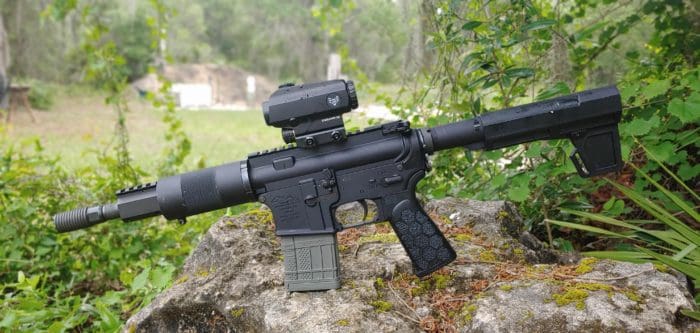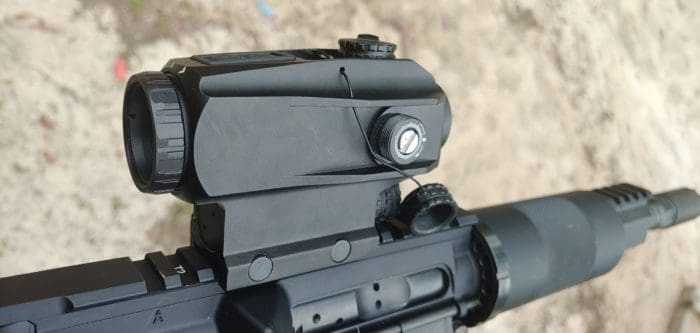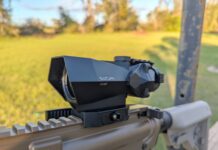What is the point of a 1X prism sight? Some will most certainly point out that a 1X prism is a red dot replacement for those with astigmatism. The dot in a prism sight won’t streak, blur and go crazy like a standard red dot for those who suffer from astigmatism.
That’s true, but a prism has more advantages than that, especially when compared to a conventional red dot. The Swampfox Blade is one such prism sight.
The Swampfox Blade is a 1x prism sight that comes with either a red or a green illuminated reticle. There are ten illumination levels, with the first two being night vision compatible. Settings 9 and 10 are incredibly bright.
The Blade uses a single CR123 battery and uses what Swmapfox calls a Shake N’ Wake motion sensing technology. After 225 seconds without moving, the optic shuts down. When moved again, the optic wakes up and lights up once again.
The Blade sight comes with an integral mounting system, flip-up caps, and a honeycomb anti-reflective device.

Swampfox makes a good number of affordable red dots, variable optics, LPVOs, and more recently, prism optics. The Blade is their first prism and it’s a simple design. Simple but seemingly very effective.
One of the main reasons a 1X prism can be more effective than a red dot is because of the reticle.
That Reticle
With the Blade, the reticle is a simple system that gives you holdovers designed not for bullet drop but for precision close-range shooting. The multiple holds in the reticle are intended specifically to deal with height over bore correction. Have you ever shot a rifle super close to a target? If you’ve zeroed your optic for something like 50 to 200 yards, then the round is likely hitting low.
The Blade reticle and its holdovers are designed for precision at ranges from 50 to 200 yards as well as from 5 to 15 yards. The reticle is best explained here with an infographic from Swampfox:

The Blade outperforms a red dot by giving you precision for those extreme close quarters shots. These specific holdovers are designed for an AR-15 rifle in 5.56, but can be applied to other weapons. You’ll just have to range out the holdovers for stuff like PCCs or 7.62 weapons.
The reticle is etched, so should the battery die, you can still use it. Also, if you use a bright weapon light, the reticle won’t wash out it will only appear as a black, easily usable reticle. Once you set the illumination level, you can turn the optic off and it saves your last setting.
Red Dots and Prisms
There are some differences between red dots and prism sights to be aware of. Red dots are lighter, smaller, and offer unlimited eye relief. Those are also most certainly advantages.
The Blade doesn’t provide unlimited eye relief, but it’s very forgiving and quite long. The optic is also considerably larger than even most full-sized red dots. It’s also heavier — an Aimpoint Micro T-2 weights about 4 oz. compared to the Blade’s 13 oz. — so be aware of that.
Hitting the Range
The Blade prism sight is quick and easy to mount. Zeroing requires a piece of brass, or a flathead driver. Or just use to tool Swampfox includes in the box. The recommended zero is your typical 50/200, but that obviously changes depending on your firearm.
I used an old AR pistol I built mostly from spare parts. It’s a fun gun that didn’t have an optic, so boom, now we’re rocking and rolling.
Once the Blade was installed, I started at 25 yards to make sure I was at least on paper and backed off to 50 yards to complete the zero. The tool included was quite handy, as were the tethered turret caps.

At 50 yards, the tip of the chevron was dead-on. I wanted to check the bullet rise compensation at 5, 10, and 15 yards. I thought it might be a little off because I’m using a 7.5-inch barrel, but to my surprise, the optic was still dead-on.
At close range, the bullet rise compensator was entirely accurate. It was humorous and enjoyable how perfect each little hashmark was.
For something like a failure drill, I just park the reticle in the center of the target and drop two rounds. When I transition to the well-aimed headshot, I can use the appropriate marker dependent on the range.

Like a red dot, the Swampfox Blade is used with both eyes opened and it’s just as fast. The eye relief is genuinely forgiving, and you don’t have to hunker up to it like an ACOG. It allows for rapid engagement and seems to be just as fast as any red dot.
The glass is clear and tint-free, the green reticle is sharp and easy to see and it’s comfortable to use for prolonged time periods. Swampfox backs the optic with a 50,000 round guarantee.
To be fair, they don’t actually track the rounds you’ve fired through the optic. They just assume if the optic has broken, it’s happened at under 50,000 rounds, and they need to take action. If the optic breaks post 50K, they assume you’ll be satisfied to buy another one.
This is my first time shooting with a 1X prism and I’m impressed. It’s well-made, easy to use, and packed with useful features. The Swampfox Blade is available here.
Specifications: Swampfox Blade 1×25 Prism Sight
Lens Diameter: 25mm
Weight: 13.1 ounces
Illumination Settings: 10
Max Battery Life: 3000 hours
Eye Relief: 3.8 inches
Adjustment Value: 0.5 MOA per click
Waterproof Rating: IPX7 (1 meter for 30 min)
MSRP: $289
Ratings (out of 5 stars):
Clarity: * * * * *
The Swampfox Blade is a 1X optic, so obtaining clear glass is relatively easy. The glass is nice and clear without any tint, and seeing and using the reticle is very easy.
Ergonomics: * * * *
The controls are minimal and placed at the top for easy access. The capped turrets are very nicely made, and the mount is simple and effective. The downside is, of course, the weight. Red dots with a 25mm objective lens can weigh less than 5 ounces with an integral mount. The Blade is on par with the Aimpoint Comp M4 weight wise.
Reticle: * * * * *
Not only is the Blade’s reticle handy and easy to use, but it’s dead-on. The close quarters rise compensation is new to me, and it’s a great addition for an optic designed for close quarters. It’s crisp and easy to see too. Add in the fact that it’s etched and will work perfectly well without a battery.
Overall: * * * *
Factoring in the under $300 price tag, this really is an awesome optic. It’s most certainly a good option for home defense and even law enforcement use. The military may want something a bit more bombproof, but for most users, this is a great rifle optic.




Nice, not $300 nice
Agree…it seems awfully large & heavy too. There’s a dizzying # of optics out there!
Indeed. I couldn’t decide on a LPVO or a red dot for my AR, so I “compromised” and put on a 2.5x Primary Arms prism scope with their fancy ACSS reticle. Was wondering if it would be the best of both worlds or the worst of both worlds. So far it has been excellent.
Weight seems to be inline with other prism scopes. These are weights I found at online retailers.
PA Cyclops -10oz
new PA 2x – 11oz
PA 2.5x – 15oz
Vortex Spitfire – 11oz
Burris ARX1 – 13oz
Steiner S332 3x – 21oz
I have the PA Cyclops and it’s pretty good EXCEPT that the reticle isn’t daylight bright. The reticle is invisible against a black target on a very bright day. That disqualifies it for use on anything other than a non-self-defense plinker, which is where I put mine after discovering its deficiencies.
Agreed; they could charge $500 and it would still be worth it.
China? I couldn’t find it listed on the website.
I don’t think it’s made of China. Probably Aluminum or some lightweight alloy. China would break too easily I would think.
😉
and get you and everybody you know really really sick
I’ve been using their Tomahawk for a while now and I’m pretty satisfied with what I bought. Read in to their business model before passing judgement and check in to their MIL/LE program, you’ll be happy you did, that is if you’re qualified.
They’re pretty straight forward and have a no B.S. approach and one of the top noggins there worked for Primary Arms for a while and the entire crew is pretty responsive.
Thanks for the heads up about that – I’m skeptical about companies I haven’t heard of before.
I used that discount and ordered one 🤷♂️.
I’ve got 2 other prism sights- Burris AR 332 (3x) and my sweet baby Vortex Spitfire (1x). I’ll report back and give my opinion when I get it.
Why do you need a piece of brass or anything other than the turret covers to adjust the windage and elevation? The notch on top of each turret cover is designed to be used to adjust the knobs in the field.
For a short time only whenever you order a swamp fox optic, it comes with a free order of Chinese Flu and communist oppression, its a 3 for 1 deal!
Seriously, one thing we do not need is to support the ccp by advertising Chinese manufactured products.
Do you have any evidence that this product is made in China?
“The dot in a prism sight won’t streak, blur and go crazy like a standard red dot for those who suffer from astigmatism.”
Then I’m guessing we’ll be seeing more and more of these. I’m interested.
Curious, I have outfitted 3 of my AR’s with the Vortex Strike Eagle 1×8 and have become pretty good with it. I bought them as B-stocks for barely 100.00 more each than this. Why would this be a better idea if I can dial something like the SE down to 1x but still have the ability to take it out to 8x? Weight?
I think this competes against typical red dots instead of LPVOs. The benefit against red dots would be the non-blurriness for some of us.
As far as red dot vs LPVO, IMO, the benefit of a red dot or this would be true 1x, no need for extra magnification, and much longer battery life.
A few things. Your 1x isn’t a true 1x. This makes shooting with both eyes open more difficult because the eye looking through the optic is getting some magnification, even if it’s only a small amount. This maters for some people, but not everyone.
Prismatic optics have the ability to run without power if the battery dies, you have the etched glass.
My “battle” rifle has a PA 2.5x to save space, I didn’t want a foot long scope on top. The weight savings are marginal, my 2.5x weighs just under 15 oz. My Uncle’s Strike Eagle 1-6 w/ mount weighs 17.5 oz.
Ultimately it boils down to personal preference. I like low magnification fixed power optics like 3x, and my astigmatism is becoming an issue with red dots so I’ve been replacing my red dots with quality iron sights or low power 1x, 2.5x prismatic optics and low power traditional scopes.
One of my favorite optics is the Redfield Revolution 2-7x33mm Riflescope withAccu-Range Reticle. Larger reticle circle can be used for cqb and the optic still has a few bdc refrences, although you have to learn them for each caliber you shoot.
I recently purchased the Swampfox Arrowhead 1-8X to replace my PA Raptor 1-6X. I was skeptical at first with such a new company. I pulled the trigger after talking with one of the Swampfox guys who actually worked at PA in the past. I have no regrets whatsoever as the quality of this scope is top notch with better glass than PA, lockable and zero stop turrets, and a throw lever. The price difference was marginal in my opinion. There are two reticles to choose from – BDC (similar to PA ACSS) and MOA which is what I got. And yes, these are built in China like so many others, though it looks like Swampfox does a good job on QC.
I’m actually considering putting this on a shotgun! the G Force MKX3! If unfamilier, It’s an AR style shotgun! It has flip up sights, so I’m pretty sure it will co-witness! using the circle, I think it will make a fine sight!
Comments are closed.